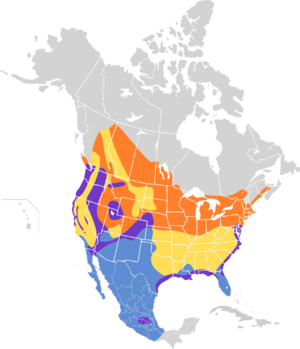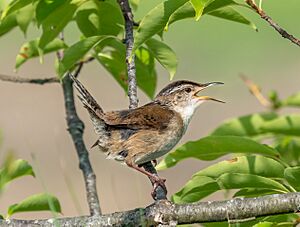Marsh wren facts for kids
Quick facts for kids Marsh wren |
|
|---|---|
 |
|
| In Canada |
|
| Conservation status | |
| Scientific classification | |
| Genus: |
Cistothorus
|
| Species: |
palustris
|
 |
|
| Distribution map
Breeding Migration Resident Non-breeding |
|
| Synonyms | |
|
Telmatodytes palustris |
|
The marsh wren (Cistothorus palustris) is a small North American songbird from the wren family. People sometimes call it the long-billed marsh wren to tell it apart from the sedge wren, which is known as the short-billed marsh wren.
Contents
About the Marsh Wren

Adult marsh wrens have brown feathers on their backs. Their bellies and sides are light brown. Their throats and chests are white. They have a black back with white stripes.
These birds also have a dark cap on their heads. A white line runs over their eyes. They have a short, thin beak.
The male marsh wren sings a loud, gurgling song. This song helps him show other birds that a certain area is his territory. Male wrens in the western United States have even more different songs.
Where Marsh Wrens Live
This small bird lives in Canada, Mexico, and the United States. They like to build their nests in marshes. These marshes must have tall plants like cattails. You can find them all over North America.
Some marsh wrens stay in the western United States all year. Other birds migrate to warmer places. They fly to marshes and salt marshes in the southern United States and Mexico for winter. Their breeding areas are in the northeastern United States and Canada.
Size and Weight
Marsh wrens are small birds. Here are some facts about their size:
- Length: About 3.9 to 5.5 inches (10 to 14 cm)
- Weight: About 0.3 to 0.5 ounces (8.5 to 14 g)
- Wingspan: About 5.9 inches (15 cm)
What Marsh Wrens Eat
Marsh wrens are active hunters. They look for food in plants near the water. Sometimes, they fly up to catch insects in the air.
They mostly eat insects. They also enjoy spiders and snails. In California, scientists looked at the stomachs of 53 Western Marsh Wrens. They found that the birds ate:
- Bugs (29%)
- Caterpillars and chrysalids (17%)
- Beetles (16%)
- Ants and wasps (8%)
- Spiders (5%)
- Other insects like flies, grasshoppers, and dragonflies
Ants and wasps were eaten more often in the fall.
Nesting and Reproduction
The nest of a marsh wren is shaped like an oval. It is attached to plants in the marsh. The birds enter the nest from the side.
Male marsh wrens build many nests in their territory. Most of these nests are not used for eggs. Scientists think these "dummy" nests might be for attracting a female. The female then builds the "breeding nest" where she lays her eggs.
Male wrens might also harm the eggs or young of other birds nearby. This can include other marsh wrens or even red-winged blackbirds.
A female marsh wren usually lays four to six eggs. However, she can lay anywhere from three to 10 eggs. The eggs are usually about 0.6 to 0.7 inches (1.5 to 1.8 cm) long. They are about 0.4 to 0.6 inches (1.0 to 1.5 cm) wide.
Only the female bird sits on the eggs to keep them warm. She is the only one who develops a special patch on her belly for this. Young marsh wrens can sometimes get sick from tiny fly larvae. These larvae can create wounds on the young birds' skin and feed on their blood.
Conservation Status
The marsh wren is still a common bird. There are an estimated 9.4 million breeding marsh wrens around the world.
However, their numbers have gone down. This is because their wetland homes are being lost. If marshes are completely drained, these birds will disappear from those areas. Even so, the species is still widespread. This means it is not considered threatened by the IUCN.
Gallery







